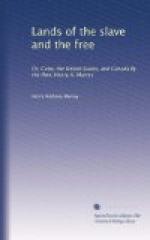CHAPTER XI.
New Orleans.
New Orleans is a surprising evidence of what men will endure, when cheered by the hopes of an ever-flowing tide of all-mighty dollars and cents. It is situated on a marsh, and bounded by the river on one side, and on the other by a continuation of the marsh on which it is built, beyond which extends a forest swamp. All sewerage and drainage is superficial—more generally covered in, but in very many places dragging its sluggish stream, under the broad light of day, along the edges of the footway. The chief business is, of course, in those streets skirting the river; and at this season—December—when the cotton and sugar mania is at its height, the bustle and activity is marvellous. Streets are piled in every direction with mounds of cotton, which rise as high as the roofs; storehouses are bursting with bales; steam and hydraulic presses hiss in your ear at every tenth step, and beneath their power the downy fibre is compressed into a substance as hard as Aberdeen granite, which semi-nude negroes bind, roll, and wheel in all directions, the exertion keeping them in perpetual self-supplying animal steam-baths. Gigantic mules arrive incessantly, dragging fresh freight for pressure; while others as incessantly depart, bearing freight for embarkation to Europe. If a pair of cotton socks could be made vocal, what a tale of sorrow and labour their history would reveal, from the nigger who picked with a sigh to the maiden who donned with a smile.
Some idea may be formed of the extent of this branch of trade, from the statistical fact that last year the export amounted to 1,435,815 bales[T]—or, in round numbers, one and a half millions—which was an increase of half a million upon the exports of the preceding twelve months. Tobacco is also an article of great export, and amounted last year to 94,000 hogsheads, being an increase of two-thirds upon the previous twelve months. The great staple produce of the neighbourhood is sugar and molasses. In good years, fifty gallons of molasses go to a thousand pounds of sugar; but, when the maturity of the cane is impeded by late rains, as was the case last year, seventy gallons go to the thousand pounds of sugar. Thus, in 1853, 10,500,000 gallons of molasses were produced, representing 210,000,000 pounds of sugar; while, in 1854, 18,300,000 gallons of molasses were produced, being nearly double the produce of the preceding year, but representing only 261,500,000 pounds of sugar,—owing, as before explained, to the wet weather. Some general idea of the commercial activity of New Orleans may be formed from the following statistics for 1853:—2266 vessels, representing 911,000 tons, entered New Orleans; and 2202 vessels, representing 930,000 tons, cleared.
Now, of course, the greater portion—or I might almost say the whole—of the goods exported reach New Orleans by the Mississippi, and therefore justify the assertion that the safe navigation of that river is, in the fullest sense of the term, a national and not a local interest, bearing as it does on its bosom an essential portion of the industrial produce of eleven different States of the Union.




